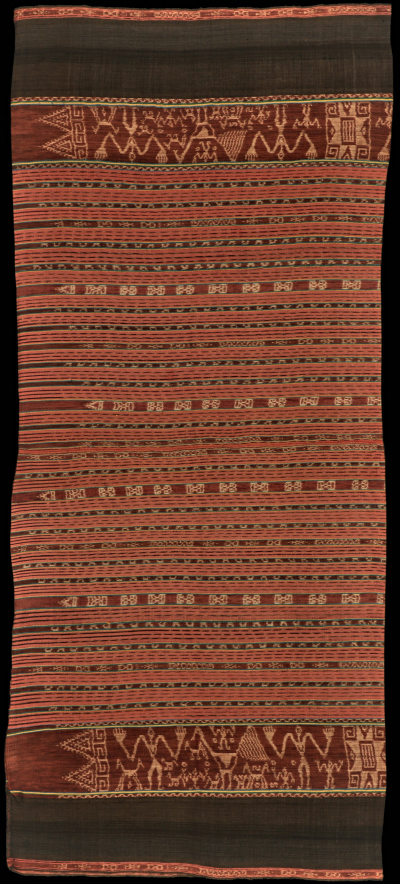| |
 
 | | | |
101 Moluccas, Kisar
Homnon (sarong) 
| | Locale: | Probably Oirata people. | | Period: | 1910-1930 | | Yarn: | Cotton, hand-spun, medium | | Technique: | Warp ikat | | Panels: | 2 | | Size: | 64 x 145 cm (2' 1" x 4' 9") LW: 2.27 | | Design: | Homnon (sarong) for high ranking woman. The two wider ikated bands are decorated with the rimanu motif: human figures with raised arms, horses, cocks or jungle fowl, double eagles, and other animals. Narrow horizontal bands decorated with small geometrical patterns; four slightly wider bands carry an hour-glass shaped motif also seen in Tanimbar and small base-mounted tumpal finials. | | Comment: | Old Kisar sarong for woman of the nobility in excellent condition - a prime example of the type. Few of these cloths have been described in literature. | | Background: | Chapters on Moluccas and Kisar. | | Exhibited: | Museu do Oriente, Lisbon, 2014/15 | | Published: |
Woven Languages, 2014.
Orientations Vol. 46/2014.
Ikat Textiles of the Indonesian Archipelago, 2018.
| | Compare: | 102 103 138 091 282 | | Sources: | Nearly identical to homnon from kampung Wonreli in Textile Museum, Washington, EX.77.279, depicted in Hunt Kahlenberg, Textile Traditions of Indonesia, Fig. 63. Nearly identical motifs on panel for sarong in Khan Majlis, Woven Messages, Fig. 310, and sarong on Fig. 311. Nearly identical to sarong in Museum für Völkerkunde, Vienna, Cat. no. 175017. Very similar to one in Tropenmuseum, Tillman collection, and to Pusaka Collection Nr. 102, 103, and 134. | | |

©Peter ten Hoopen, 2025
All rights reserved.
|
|


